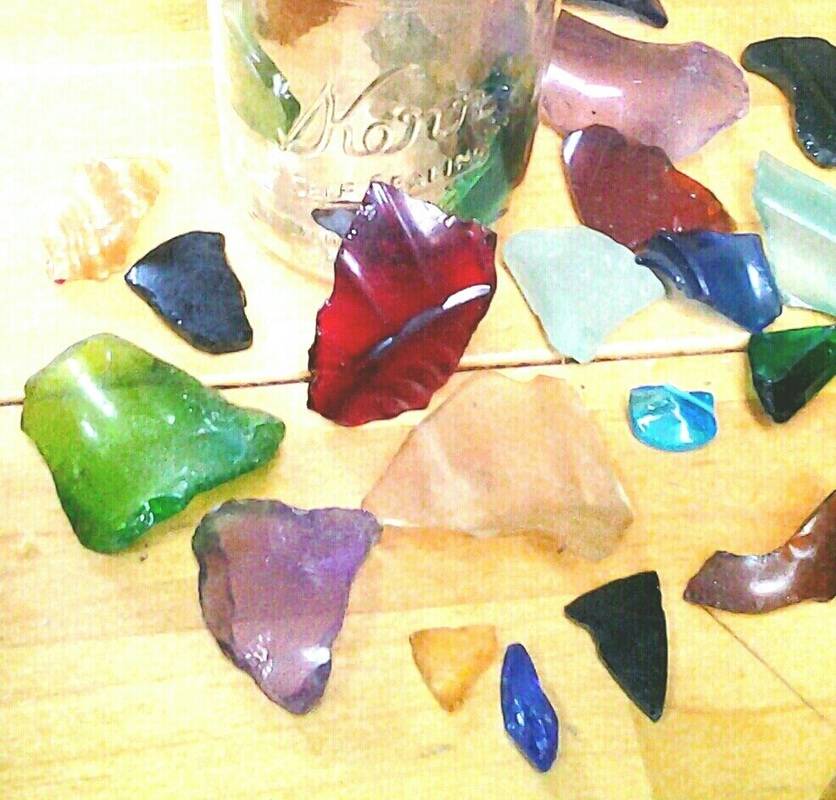It may have slept at the bottom of the sea in a deteriorating hulk until rolled in a storm tide and set free to roam until it’s tumbled and ground on a gravel or rock beach, to float again and travel to yet another shore. Its journey could last years, decades, even centuries, until finally someone strolling along a surf-washed beach catches a bit of color out of the corner of their eye and bends down to pick up a piece of worn glass.
We’ve always called these bits beach glass, but apparently the experts differentiate between glass found on freshwater shores and saltwater shores. The former is called beach glass, while the latter is sea glass.
The best times to look for sea glass are during spring tides and the first low tide after a storm.
Inside and outside my house I have jars, glasses, and vases filled with sea glass that I’ve put in my pockets after an amble along the shore. Everyone around here has their own stash. Some plan to make jewelry with their glass treasures, others just like to collect them. I know one woman who collected so much sea glass that she put it in a five gallon bucket.
The most common colors are green, brown, and white (clear). Uncommon colors are purple (amethyst), citron, and opaque white. Extremely rare colors include gray, pink, teal, very dark olive green, yellow, turquoise, orange, red, and black.
Over the years, wandering remote Alaskan beaches, I’ve found almost all of these colors, from the common to the rare. And what I like to do is make sea glass candles with them.
Some people who make sea glass candles glue the glass to a jar. But because many of my pieces are rare, I prefer not to fix them permanently. Besides, I like a “floating” look that harkens back to where they originated. To acquire this look I put a smaller jar inside of a Mason canning jar and then fit the pieces of sea glass in between the jars.
As I assemble the candle holder I try to vary the colors and fit them as closely together as possible—it can take several tries, dumping them out and starting over. Using a pair of tweezers to maneuver the pieces of glass to different places is helpful.
Handling the glass, some of it frosted from years of journeying, others with edges barely rubbed down, I like to imagine where each piece might have come from and what it had originally been and how it acquired its color.
For instance, the uncommon purple (amethyst) sea glass was originally from clear glass that had manganese in it. The glass turns purple over time as the manganese is exposed to sunlight and sea action. This sort of glass saw its peak production during the late 1800s to early 1900s.
Red glass, extremely rare and highly prized by collectors (some consider it more valuable than diamonds), comes mainly from the Victorian to Depression years. One reason why it’s considered so valuable, besides its beauty, is that the chemical process to make it is complicated and expensive so that the production of red glass has been limited in the last fifty years. Most red glass you’ll find on the beach, therefore, is rare and antique.
Black glass can be even older, and was common aboard the ships of the early explorers, including Columbus. The thicker the black sea glass you find, the more likelihood that it could be from the fifteenth through seventeenth centuries. Black sea glass is actually a dark brown or dark green, which you can see when it’s held up to a strong light. Weathering and oxidation, along with UV light interacting with metallic oxides and chemicals in the glass, not to mention the effects of seawater on it, are all factors that turn the glass black. It can look like a beach rock and is easy to overlook.
So, the next time you’re walking along the water’s edge and see a fragment of glass, you may find yourself holding a piece of history, highly valued by collectors around the world. Or you may find a common piece that you can add to your sea glass candle holder. Whatever the case, enjoy your treasure from the sea.

